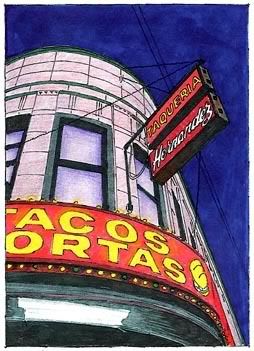When you're done looking at the polished brass entrance, go inside the lobby and admire the weird geometric ducks and elaborate deco lighting standards. Unfortunately there's scaffolding on this building that's probably been there for years. But take a look at the low relief panels visible from Madison. They're supposed to commemorate the explorations of Robert Cavalier, Sieur de La Salle, who supposedly camped on the site. (Thanks AIA Guide to Chicago!)
So, I'm on my own until next Wednesday. Angela and Felix are in Ohio visiting the grandfolks. Since I don't have vacation hours until next year, I opted to stay in Chicago. I thought it might be fun, but I find myself feeling depressed and lonely. Maybe this weekend I'll do all the things I say I miss about being single, like going to movies, drinking too much coffee, doing the used bookstore circuit. Adventurous, right?
But when I got home tonight I really missed them. Felix has this new thing where he tries to put his finger right through my belly button. It's extremely funny, but also kinda painful. I missed that. Well, it's just a few days. Maybe tomorrow I'll start enjoying my solitude like I used to. Or not.
On another note, MySpace sucks when you use a Mac. I don't get the simple editing tools, and it seems slower. But I still get messages from 19 year olds inviting me to subscribe to their web cam.



















